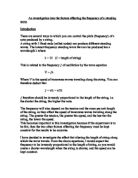What factors affect the bounce of a squash ball?
What factors affect the bounce Of a squash ball? Observations: The modifications that were made during the practical portion of the investigation to improve the plan included the following: * The ball was put back into the water each time it needed to be dropped again for each given temperature between 0?C and 80?C Table of Results: Temperature of the ball (?C) The rebound height of the ball (Cm) Average rebound height (Cm) Reading 1 Reading 2 Reading 3 2.5 7.0 9.0 6.5 7.5 1.0 4.0 4.5 5.0 4.5 20.5 8.0 7.5 7.5 7.7 31.0 21.0 22.0 20.5 22.7 40.0 26.0 28.0 27.0 27.0 51.5 33.0 34.0 32.5 33.2 60.0 42.0 43.0 44.0 43.0 70.5 47.0 47.5 50.0 48.2 82.0 54.5 54.0 56.0 54.8 90.0 56.0 55.5 56.5 56.0 Other observations: * When the temperature reached 70?C the ball started to become incompressible and when the temperature of the water reached near the 80?C mark, the ball started to melt. * When the ball was dropped it was quite difficult to read the observations due to a couple of reasons. One reason was that at the start of the experiment the rebound height of the ball was quite small hence it was difficult to read while most the time when the ball was dropped it happened so fast that it seemed strenuous to read the rebound height. * When the water temperature became higher condensation formed on the thermometer due to
Wind Power.
Wind Power The wind turbine, also called a windmill, is a means of harnessing the kinetic energy of the wind and converting it into electrical energy. This is accomplished by turning blades called aerofoils, which drive a shaft, which drive a motor (turbine) and ar e connected to a generator. "It is estimated that the total power capacity of winds surrounding the earth is x 1011 Gigawatts" (Cheremisinoff 6). The total energy of the winds fluctuates from year to year. Windmill expert Richard Hills said that the wind really is a fickle source of power, with wind speeds to low or inconsistent for the windmill to be of practical use. However, that hasn't stopped windmill engineers from trying. Today, there are many kinds of windmills, some of which serve differen t functions. They are a complex alternative energy source. What to consider when building a windmill In choosing where to build a windmill, there are many important factors to consider. First is the location: 1) Available wind energy is usually higher near the seacoast or coasts of very large lakes and offshore islands. 2) Available wind energy is gene rally high in the central plains region of the U.S. because of the wide expanses of level (low surface roughness) terrain. 3) Available wind energy is generally low throughout the Southeastern U.S. except for certain hills in the Appalachian and Blue Rid
Bouncing Ball Experiment
Aim: To find out what affects the height to which a ball bounces. Variables: Height from which the ball is dropped Mass of the ball Material ball is made from External factors, i.e. changing air density, temperature The surface onto which the ball falls Prediction - reasons for variable control: Variables that will be altered: The height the ball is dropped from will affect the height the ball bounces to due to the energy chain the ball goes through as it is dropped and bounces up again. The energy chain is as follows: Therefore as energy cannot be created or destroyed the energy the ball starts with must be directly proportional to the energy the ball finishes with, at the top of its bounce, and so if the ball starts with more energy it must therefore finish with more. As in both cases the main form of energy is GPE it follows that the higher the ball is dropped from, the higher the ball will bounce. * The ball starts with more GPE * As there is more GPE more energy is converted into KE (The ball is going faster, KE=1/2mv2, v is greater therefore KE is greater by a larger amount). More thermal energy is also produced. * As there is more KE, more energy is converted into elastic potential energy * As there is more elastic potential energy, more energy is converted back into KE energy * As there is more KE energy, more work would need to act upon the ball in




















